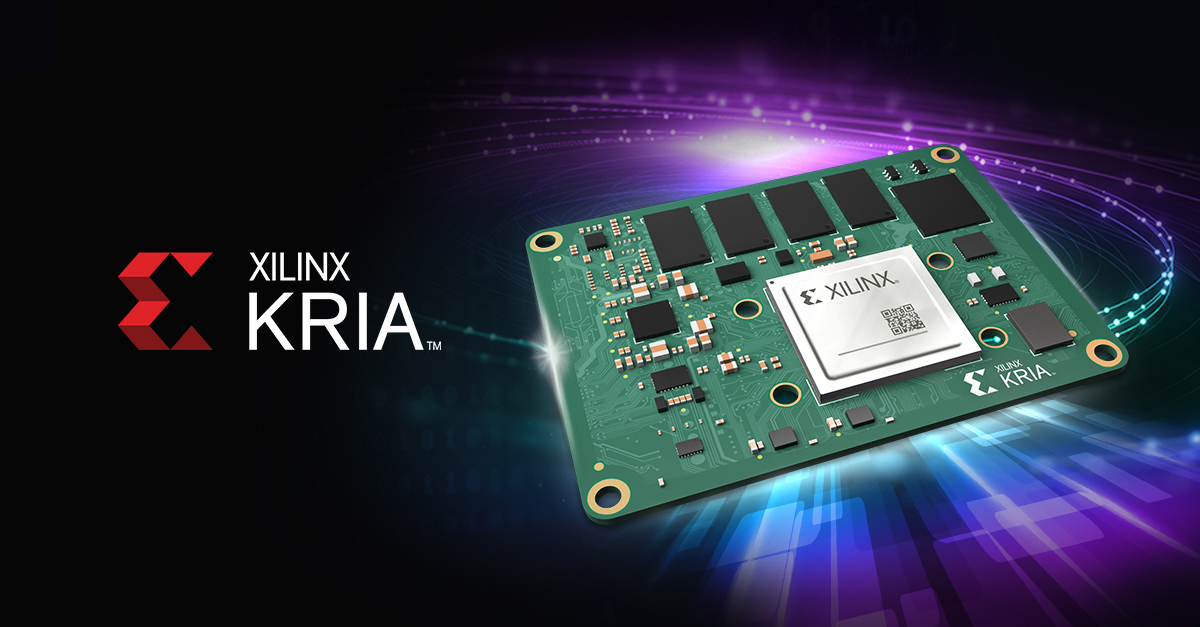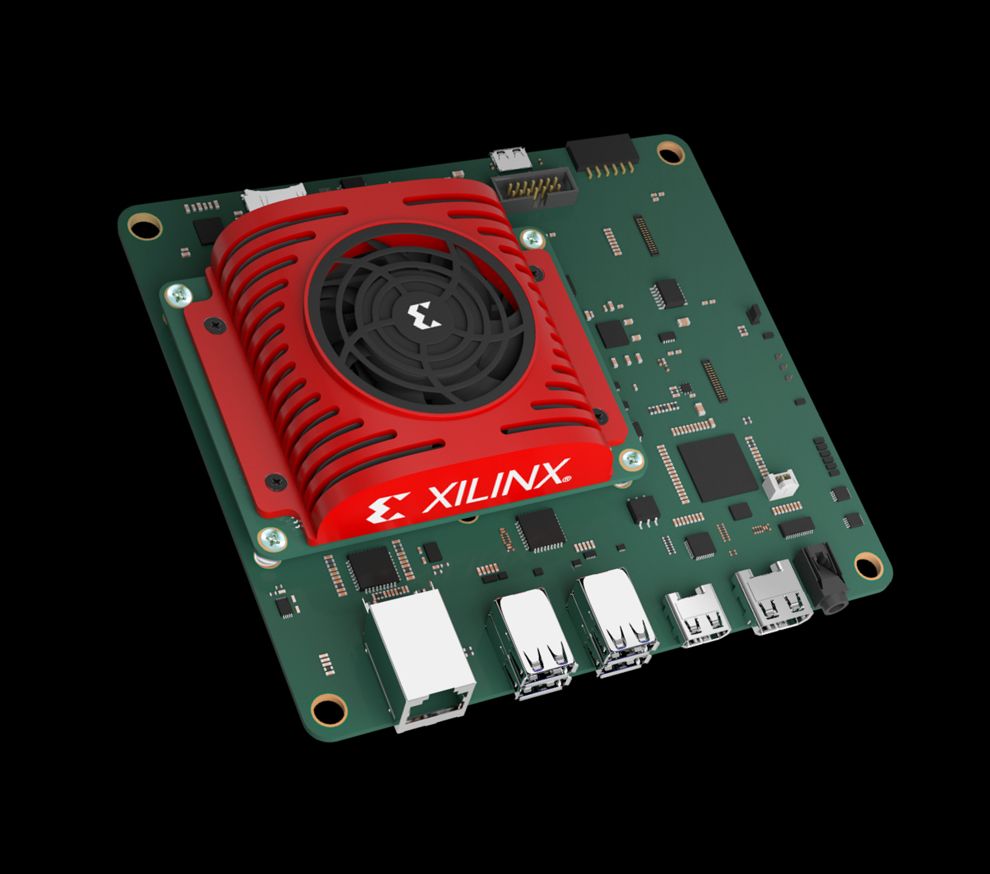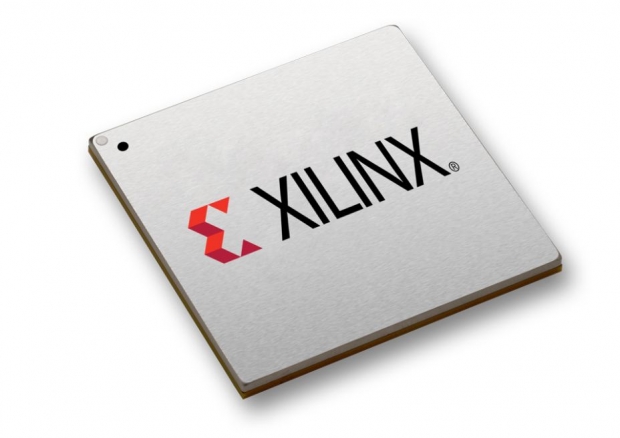Xilinx introduced the Kria portfolio of adaptive system-on-modules (SOMs), production-ready small form factor embedded boards that enable rapid deployment in edge-based applications.
Coupled with a complete software stack and pre-built, production-grade accelerated applications, Kria adaptive SOMs are a new method of bringing adaptive computing to AI and software developers.
Adaptive System on modules for edge application have many advantages. One of the key ones is that Kria is a production system on module solution that can quickly deploy smart vision applications. One of the vital target areas are smart cameras. Furthermore, the System on modules approach is enabling software developers familiar design environment, and previous customers can have a faster time to market as the software usually doesn't need a lot of tweak ups.
SOMs are out of the box, ready for deployment, and provide a low-cost development kit for the prototyping phase.
The small factor PCB is the heat of the SOM, and it comes with a processor, RAM, and peripherals.
The system on module market is expected to grow at roughly 11 percent annually, and total market revenue is expected to reach $2.3 billion by 2025.
Vision AI
SOM will find its home in smart and complex vision AI applications (cameras) with a strong position in security cameras, object detection and identification, and medical imaging analysis. It will also find its place in AR/VR, consumer photography, emotion analysis, image recognition, classification, and face recognition as some of the dominant use case scenarios by revenue.
Artificial intelligence (AI) is constantly evolving, and Xilinx's adaptable DNA is helping out as it can update the Kria K26 SOM hardware and add support for the new libraries and neural networks when necessary.
Kria K26 SOM
The first product available in the Kria SOM portfolio, the Kria K26 SOM, specifically targets vision AI applications in smart cities and smart factories. The Xilinx SOM roadmap includes a full range of products, from cost-optimized SOMs for size and cost-constrained applications to higher performance modules that will offer developers more real-time compute capability per watt.
"Xilinx's entrance into the burgeoning SOM market builds on our evolution beyond the chip-level business that began with our Alveo boards for the data center and continues with the introduction of complete board-level solutions for embedded systems," said Kirk Saban, vice president, Product and Platform Marketing at Xilinx. "The Kria SOM portfolio expands our market reach into more edge applications and will make the power of adaptable hardware accessible to millions of software and AI developers."
Up to nine months faster Time to Deployment
Kria SOMs harness the power, performance and flexibility advantages of Xilinx adaptable hardware, delivered as production-deployable, adaptive modules. Kria SOMs enable rapid deployment by providing an end-to-end board-level solution with a pre-built software stack. By allowing developers to start at a more evolved point in the design cycle compared to chip-down design, Kria SOMs can reduce time-to-deployment by up to nine months.
The Kria K26 SOM is built on top of the Zynq® UltraScale+™ MPSoC architecture, which features a quad-core Arm Cortex™ A53 processor, more than 250 thousand logic cells, and a H.264/265 video codec. 250 thousand logic cells can be hardware programmed via Vitis ulifiend software development platform or low level programming approach.
The SOM also features 4GB of DDR4 memory and 245 IOs, which allow it to adapt to virtually any sensor or interface. With 1.4 tera-ops of AI compute, the Kria K26 SOM enables developers to create vision AI applications offering more than 3X higher performance at lower latency and power compared to GPU-based SOMs, critical for smart vision applications like security, traffic and city cameras, retail analytics, machine vision, and vision guided robotics.
Enabling Millions of Software Developers
Xilinx has invested heavily in its tool flows to make adaptive computing more accessible to AI and software developers without hardware expertise. The Kria SOM portfolio takes this accessibility to the next level by coupling the hardware and software platform with production-ready vision accelerated applications. These turnkey applications eliminate all the FPGA hardware design work and only require software developers to integrate their custom AI models, application code, and optionally modify the vision pipeline – using familiar design environments, such as TensorFlow, Pytorch or Café frameworks, as well as C, C++, OpenCL™, and Python programming languages—enabled by the Vitis™ unified software development platform and libraries.
With this new accelerated-application paradigm for software-based design, Xilinx is announcing the first embedded app store for edge applications. Building out beyond its Alveo™ catalog of apps for data center, the Xilinx App Store now offers customers a wide selection of apps for Kria SOMs from Xilinx and its ecosystem partners. Xilinx offerings are open source accelerated applications, provided at no-charge, and range from smart camera tracking and face detection to natural language processing with smart vision.
Kria SOMs also enable customization and optimization for embedded developers with support for standard Yocto-based PetaLinux and, for the first time ever, Xilinx is announcing a coming collaboration with Canonical to provide Ubuntu Linux support, the highly popular Linux distribution used by AI developers. This offers widespread familiarity with AI developers and interoperability with existing applications. Customers can develop in either environment and take either approach to production. Both environments will come pre-built with a software infrastructure and helpful utilities.
"For smart vision applications, developers and innovators want the Ubuntu experience they're used to from cloud to desktop," said Thibaut Rouffineau, vice president of marketing, Canonical/Ubuntu. "Together with Xilinx, we're excited to provide Kria SOM customers with out-of-the-box productivity, frictionless transition from development to production, and guaranteed stability and security in the field."
Out-of-the-Box Ready, Low-cost Development Kit
The Kria KV260 Vision AI Starter Kit provides an affordable and easy-to-use development platform for designing vision applications, right out of the box. The kit is purpose-built to support accelerated vision applications available in the Xilinx App Store and is an excellent way to get up and running in less than an hour with no knowledge of FPGAs or FPGA tools.
Part of the Kria development experience is a self-enabled path for exploration, design, and ultimately production deployment through a vast set of online resource. Hobbyists, makers, and commercial developers alike can accelerate through each phase of the design cycle with tutorial videos, training courses, and a vast ecosystem of providers offering accelerated applications, design services, and more.
Pricing and Availability
The Kria KV260 Vision AI Starter Kit is priced at a low $199. When ready to move to deployment, customers can seamlessly transition to the Kria K26 production SOM, including commercial and industrial variants priced at $250 or $350, respectively.
Kria K26 SOMs and the KV260 Vision AI Starter Kit are immediately orderable from Xilinx and its network of worldwide distributors. The KV260 Vision Starter Kit is available immediately, with the commercial-grade Kria K26 SOM shipping in May of 2021 and the industrial-grade K26 SOM shipping this summer. Ubuntu Linux on Kria K26 SOMs is expected to be available in July of 2021. For more information, visit www.xilinx.com/kria.




